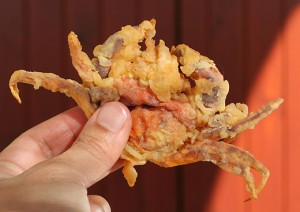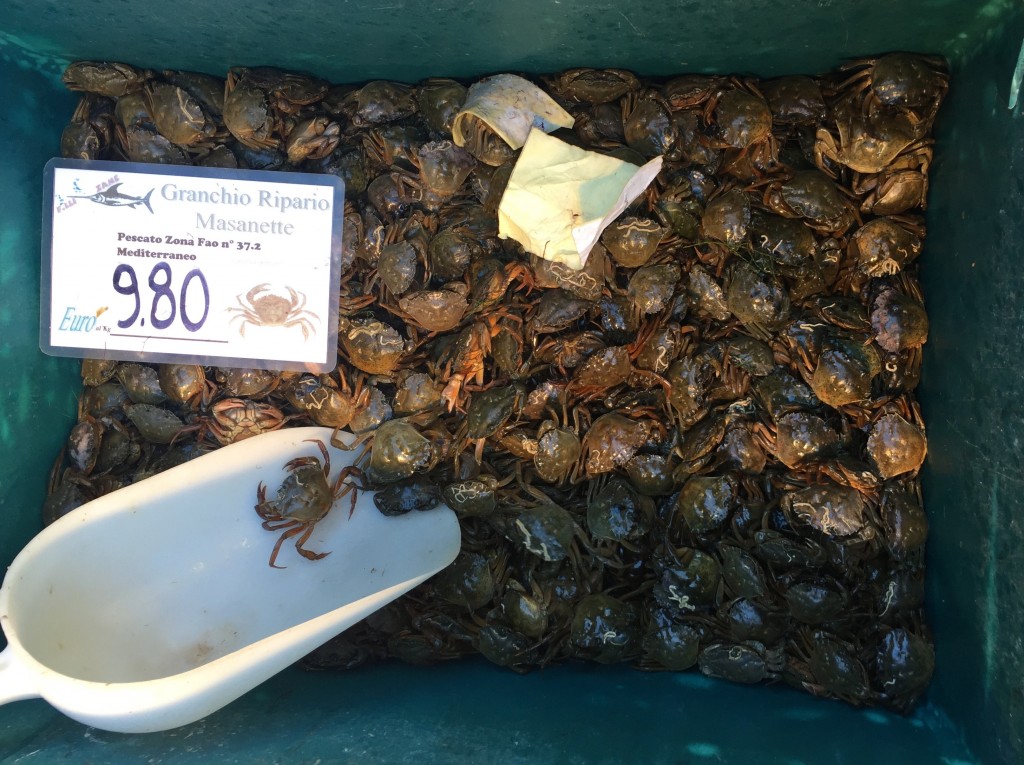 Carcinus maenas
Carcinus maenas
Native range: Atlantic Europe, North Africa
Invasive range: Northeast coast of North America, Pacific Northwest, Japan, Australia, South Africa, and South America
Habitat: Thrives on a variety of substrates, from soft mud and sand to rocks and aquatic vegetation. Reproduces well in a wide range of temperatures and salinities.
Description: Five spines on each side of carapace, with three rounded lobes between eyes. Top often mottled brown to dark green, yellow flecks. Underneath green, orange, or red. Adults about 2.5 inches wide, occasionally to four inches.
Since the green crab was first recorded off southern Massachusetts in 1817, it has been hard to ignore. A few minutes of rock-flipping in Maine can turn up dozens of them, brandishing their claws as they retreat to the crags. From Long Island to Nova Scotia on this side of the Atlantic, and from Norway to Portugal in their native range, I’ve collected hundreds of them in an effort to understand how the species arrived on our shores and then spread from New York to Prince Edward Island. DNA analysis suggests that at least two separate invasions have occurred. Green crab larvae can live up to sixty days in plankton and would have little problem surviving a transatlantic journey. One lineage, stretching from Chesapeake Bay to Halifax, probably arrived in the ballast of ships around the time of the American Revolution.
Atlantic Canada, however, has at least three additional lineages, likely the result of invasions that occurred as recently as the 1990s. The local chamber of commerce brags about the new ice-free super-port that was created when the Strait of Canso, between the Nova Scotia mainland and Cape Breton, was closed off by a causeway a few decades back. Ships from the Norwegian and British coasts regularly visit this port, unloading unrefined oil and clay, before heading back across the North Atlantic. They may have released the green crab, which feasts on native mussels and clams, critical to the economy and ecology of the Canadian Maritimes. The descendants are now found from Prince Edward Island to Long Island Sound.
These new invaders may have a few different nucleotides in their DNA, but they look and, I suspect, taste the same as the garden variety we already have here in the States. Although green crabs are small, their meat is tasty, especially when they’re in midmolt. The trouble is finding the things when they’re soft, or between shells. Blue crabs have physical cues that enable crabbers to predict when they’re about to molt, but few people can detect this moment in green crabs. I have been fortunate to discover a few softies in my exploration of the intertidal zone in Maine, but molting crabs are generally shy when they’re in this vulnerable stage–other crabs will quickly subdue them–and difficult to find.
In Italy, a closely related species, Carcinus aestuarii, is eaten with relish along the Adriatic. Fishermen harvest the crabs just before they molt: moleche, as the crabs are known, are so popular around Venice, that populations crashed in the 1980s. But the clues to predict molting in North America remain elusive: either it’s difficult to tell when green crabs are about to molt, or Venetian fishermen know just the right season to collect. Or perhaps the crabbers don’t want to reveal their secret. Researchers on Prince Edward Island, Canada, are currently studying the fishery in Italy (hardship post) to see if they can crack the secret–which may have to do with water temperature–and create a market.
After Italian cooks have the softshells in hand, the crabs are placed in an egg mixture, then fried. A fellow biologist tried this. He ended up with nothing but a few live, hand-dipped crabs, spreading yolk and breadcrumbs around the kitchen, as they scrambled to escape their deep-fried fate.
But recently, with bounties in place from Martha’s Vineyard to Maine, chefs have been taking a second look at this invader. Rich Vellante, executive chef of Legal Sea Foods in Boston, told the Boston Globe that green crab stock had a “pleasing ocean flavor.” He thought he could do something with it–and has started testing risotto and minestrone dishes.
Softshell Crabs
According to ’60s forager Euell Gibbons, soft-shell green crabs “are delicious fried, broiled, or sautéed.” In Maine, I sautéed them in butter, the simplest recipe. The first challenge, however, won’t be cooking these crabs, but finding them as softshells. Peelers are most common in late spring, under rocks low in the intertidal zone. Look for the sluggish crabs (without the hard shell as leverage, softies find it hard to scurry).
The second comes in the preparation. I felt a little guilty as I removed the peeler from the cooler, live, soft and vulnerable in midmolt, but Gibbons’ instructions were clear: “With a sharp knife remove the eyes.” That done, I sautéed it in butter and ate it with French bread. Fresh from the sea, the delicate flaky meat beat any store-bought crab I’ve had, claws down.
Adapted from Euell Gibbons’ Stalking the Blue-Eyed Scallop.
2 soft-shell crabs per person
about 2 teaspoons of butter per crab, or enough to cover the bottom of the pan
Cleaning a softshell is easy, for in this condition it is far from being its usual belligerent self and can be handled with impunity. With a sharp knife remove the eyes and the stomach, which is the soft substance just below and behind the eyes. Make a slit along each side, fold back the top skin a bit, and remove the “devil’s fingers”—or gills—those spongy strips just under the back. Rinse the crab in cold water and the job is done.
Melt butter over medium heat in a pan equipped with a tight cover. Put in the crabs, cover, and sauté for about 10 minutes, shaking or turning them occasionally so they brown to an even golden color all over.
Soft-Shells should be served with French bread. Garnish the crab with lemon slices, parsley, and watercress.
Moleche
In spring and fall, the Mediterranean shore crab, a close relative of the green crab, changes its shell. At this tender stage, the crabs are sold in Venetian markets. This recipe is for the intrepid cook—the crabs must be alive.
Adapted from Vicenza News
As many soft-shell crabs as you can find
3 egg yolks
1 cup flour
3 tablespoons of grated Parmesan cheese
salt to taste
Wash the moleche, or softshell crabs, in salt water. Beat the egg yolks and place in a bowl with a pinch of salt and Parmesan cheese. Mix the crabs with egg, allowing them to rest in the bowl for a few minutes to absorb the yolk.
Dip the crabs in flour and fry in hot oil (375 degrees for approximately five minutes or until golden brown). Dry them on paper towels to absorb the grease. Sprinkle with salt and serve hot.






























{ 4 comments… read them below or add one }
Sadly they look small enough to escape the traditional blue-crab traps used to catch blue crabs.
And any trap with wire small enough to catch these green crabs will catch lots of blue crabs too.
They seem easy enough to tell apart, and blue crabs are so expensive right now, that I’m more than willing to try my hand at pickin’ and eatin’ these smaller green crabs.
Just translate, they make great bisque!
http://www.smulweb.nl/recepten/1397447/Soep-van-de-strandkrab
Is there any other recipes for European green crabs?
I’ve hit only some big ones on the bay shore of lower Cape Cod, while clamming, but find them so delicious they are worth picking from the shell. They seem to co-exist with native crabs in the intertidal zone, I will check the estuaries when that season opens in November. If I can trap a lot of medium or small ones, I will stir-fry them black-bean sauce in the Cantonese manner. After all, they eat mussels and soft-shell clams, and I suspect the big ones on Cape Cod of eating surf clams. The only thing so far is that the big ones are solitary, so where they get a lot in marshes they are smaller, and used for bait.
{ 1 trackback }